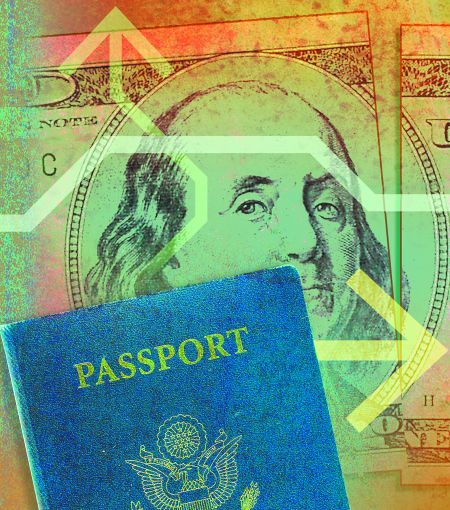New York City and the Future of EB-5 Funding
By Danielle Schlanger October 8, 2014 10:45 am
reprints
With the start of the fiscal year last Wednesday, Oct. 1, Chinese investors are again eligible to participate in the wildly popular Immigrant Investor program, widely known as “EB-5” and administered by the U.S. Citizenship and Immigration Services. As a new cycle of visa administering commences and immigration reform reemerges in the national spotlight, the future of the EB-5 program, which has become a lifeline to investors and developers throughout New York City, has come into question.-
Massive development projects across New York City have benefitted tremendously from funding obtained through the nation’s EB-5 program. A sizable portion of Brooklyn’s Barclays Center was funded through EB–5 money, and the high-profile Hudson Yards development is seeking some $800 million in EB-5 investment. Three-hundred Chinese citizens plan to invest $150 million collectively in the New York Wheel, the proposed 630-foot ferris wheel on Staten Island.
Smaller projects in the five boroughs, from hotels to infrastructure projects to historic rehabilitation, have also been beneficiaries. The Knickerbocker and Times Square hotels were both aided by the program. So was the George Washington Bridge Bus Terminal on 181st Street and Broadway and Pier A, the site of the historic Harbor House in the Hudson River at Battery Park.
“We are very supportive of the program,” said Angela Pinsky, senior vice president of management services and government affairs for the Real Estate Board of New York. “We would like to see it expanded.” She noted that REBNY was involved in helping to ensure that the program was extended in 2012.
First authorized by Congress in 1990, the EB-5 program is designed to increase the amount of foreign capital flowing through the nation’s economy while simultaneously stimulating job creation. In exchange for a capital investment of either $500,000 or $1 million in a U.S. business, investors are able to obtain conditional green cards for themselves and their dependent immediate family members (spouse and children under the age of 21). And if investments yield at least 10 permanent full-time jobs over two years, these immigrant investors are eligible for permanent green cards. Today, visas issued through the EB-5 program account for less than 1 percent of all visas in the entire immigration system, with 10,000 visas issued annually.
The U.S. Citizenship and Immigration Services estimates that a minimum of 57,300 jobs have been created and more than $8.6 billion has been invested through the EB-5 program since its inception in 1990, as of the end of fiscal year 2013, which concluded on Sept. 30, 2013.
Over the past five years, Chinese nationals have been especially eager to invest their growing amount of capital in foreign markets. As reported by The Real Deal last week, Chinese outbound property investment this year has exceeded $8.5 billion through the end of the summer. By some estimates, Chinese investors comprise 85 percent of issued EB-5 visas. (South Koreans were the next-largest demographic to apply for these visas in fiscal year 2013, followed by Taiwanese, Indian and Mexican nationals.) Alexander Rojas, a partner at New York law firm Barst, Mukamal & Kleiner specializing in immigration law, estimated that 80 percent of the EB-5 clients he sees are from China.
While some are savvy investors and know which industry they are interested in, “for the most part, people are looking to get their green card and get their money back,” he said. “They’re not necessarily looking for a good rate of return on their investment.”
However, because no more than 7 percent of immigration visas issued can come from any one country, demand for EB-5 visas in China exceeded supply in the last fiscal year.
Steven Polivy, a real estate attorney with a focus on economic development and real estate finance at Akerman, noted that “next year, depending on how many Chinese investors there are, [the retrogression] is likely to happen again, and it’s likely to happen sooner than it did in 2014.”
Mr. Polivy, who serves as chair of the firm’s economic development and incentives practice, added: “There will come a point in time in the 2014-2015 fiscal year where EB-5 visas for Chinese nationals will be restricted. After that, then every other Chinese national interested in the EB-5 program will have to wait for Oct. 1, 2015 for his or her visa to be processed.”
Peter Joseph, executive director of the Association to Invest in the USA, highlighted that since the 2008 financial crisis, many investors and developers have viewed the EB-5 program as invaluable.
“Something happened in 2008 that really flipped the capital markets on its head,” Mr. Joseph said. “Pre-2008, [real estate] projects would have had just a couple of sources of financing, likely predominantly from banks. But post-financial crisis, economic development projects need lots of different financing on the front end.”
This is what he believes makes EB-5 a “very important piece of the financing puzzle.”
“I think that EB-5 has been an important tool and it is one that will continue to be important in New York City,” Mr. Polivy said. He cited Mayor Bill de Blasio’s commitment to constructing affordable housing throughout the five boroughs and the lingering question of who will pay for it.
“The city’s current administration is focused on expanding the amount of affordable housing that is available and is being built,” Mr. Polivy noted. “EB-5 can play a very important role to fill the capital stack for affordable housing projects that are looking for financing and may not have 100 percent of their capital fully allocated, where EB-5 is more efficient and less expensive than things like mezzanine-level debt or equity.”
Mr. Rojas emphasized that with an aging baby boomer population, a number of healthcare projects including hospices and long-term care facilities are currently being financed by EB-5 funds in the Bronx.
Though EB-5 funding is heavily relied upon, the legislation has a sunset every three years and must be renewed by Congress in order to continue. The program’s last review was in 2012 and it is set to be reviewed again in September 2015. However, legislators have proposed giving EB-5 a permanent extension so renewal every three years will no longer be necessary.
Though critics of the program have stressed that money laundering and fraud have become issues and oversight by both U.S. Citizenship and Immigration Services and the U.S. Securities and Exchange Commission is lacking, Mr. Joseph sees the program as vital to compete with capital investment programs all over the world.
In contrast to other countries’ systems (there are over 20 comparable programs worldwide), if the creation of at least 10 American jobs has not been achieved, investors will have their visas revoked and deportation proceedings will begin.
Members of Congress have also voiced that the program should be made permanent.
Representative Bob Goodlatte, the chairman of the House Judiciary Committee, which oversees the nation’s immigration laws including the EB-5 program, said, “We should build upon the success of the regional pilot project by making it permanent. The investor visa program is an important part of meeting this goal as it helps grow our economy and create jobs for Americans through capital investment by foreign investors.”


